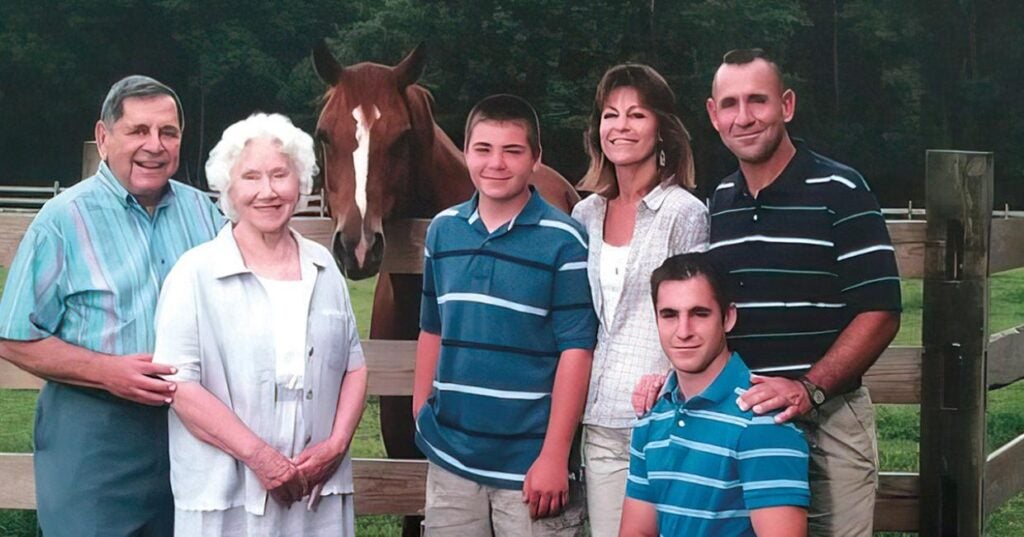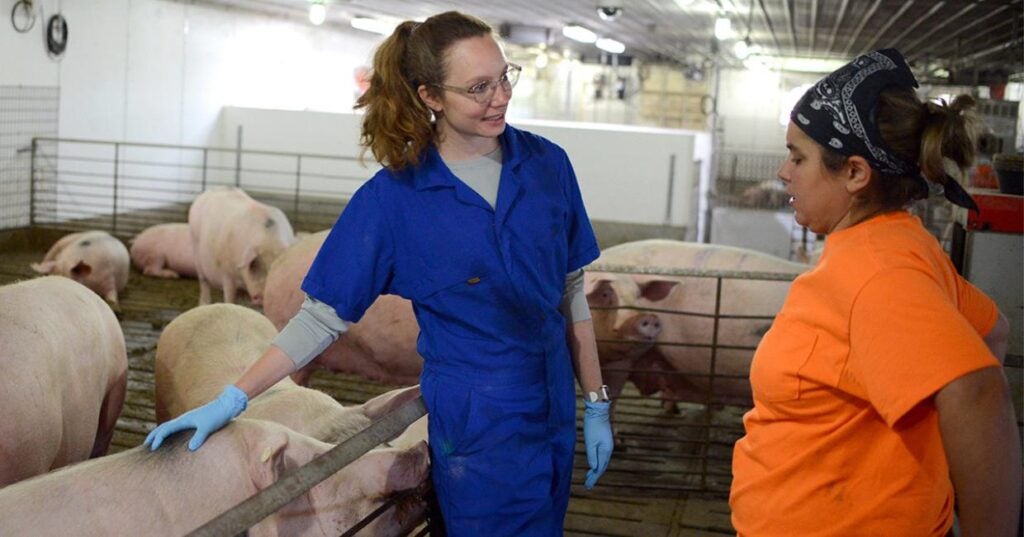Patient Gallery
New Bolton Center
Senior Senator
Eight-year-old Senior Senator nearly ended his racing career. While defending his 2016 Maryland Hunt Cup title at the 2017 race, the Thoroughbred tumbled at the third fence. Diagnosed with a serious fracture of the fourth cervical vertebra in the neck, Dr. Dean Richardson performed a successful surgery. A year after his terrible accident, in a brilliant comeback, the champ took home the 2018 Maryland Hunt Cup. Photo by Douglas Lees.
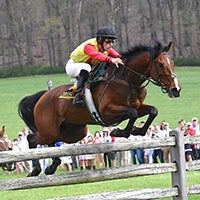
Milkshake
Milkshake was presented to New Bolton Center’s emergency service for respiratory distress. An ECG was obtained and showed atrial fibrillation and marked tachycardia. Overnight, Milkshake developed more arrhythmias, and her heart stopped several times. Her clinical care team managed her arrythmia with medication and by morning she was standing. Milkshake’s owners administer a beta blocker medication twice daily for her arrythmia. On subsequent follow-up visits, her heart rate was normal. “Her heart is doing great and there are no signs her life expectancy will be different than other goats — she has a normal goat heart, so we are very excited,” said Dr. Laurence Leduc.
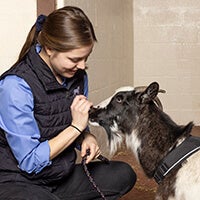
Neville Bardos
The 12-year-old, 16.1-hand chestnut gelding was admitted after barn fire smoke inhalation, mild burns, and general edema impaired his lung function. He was treated at New Bolton Center for eight days. Just eight weeks after the fire, Neville Bardos competed in one of the most grueling three-day competitions in the world, the four-star international Burghley Horse Trials. In fourth place after a clean cross-country round, Neville Bardos finished the competition seventh. Photo by Lisa Thomas.
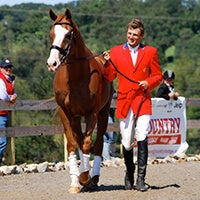
Jolene
Jolene, a 600-pound pig, needed a diagnostic tool that would accommodate her size. She and her owner made the 2,900-mile trip from Washougal, WA, to Kennett Square. Using the hospital’s robotic CT technology, clinicians diagnosed discospondylitis, a vertebral infection causing bone remodeling and swelling that pressed on the pig’s spinal cord. Surgery wasn’t required, but rest and medication were. She spent a few weeks at New Bolton Center before traveling back home.
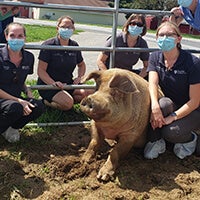
Layounne
Layounne was an 18-year-old Thoroughbred mare purchased in 1996 by Mrs. Elizabeth Moran. While eight months pregnant, Layounne colicked and was rushed to New Bolton Center. There was concern over her prognosis because her pregnancy was advanced, but surgery was a success and Layounne returned home after a 10-day stay. Her foal was born by caesarean section almost four months exactly after Layounne’s colic surgery.
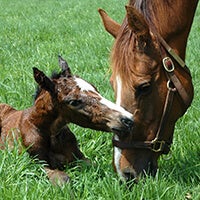
Barbaro
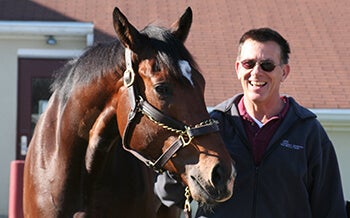 New Bolton Center’s highest-profile case was Kentucky Derby winner Barbaro, who suffered a catastrophic injury at the Preakness Stakes on May 20, 2006. Rushed from Pimlico in Baltimore, Barbaro’s ambulance was accompanied by a caravan of cars, including a police escort and hundreds of members of the media.
New Bolton Center’s highest-profile case was Kentucky Derby winner Barbaro, who suffered a catastrophic injury at the Preakness Stakes on May 20, 2006. Rushed from Pimlico in Baltimore, Barbaro’s ambulance was accompanied by a caravan of cars, including a police escort and hundreds of members of the media.
The complex surgery to repair the three fractures in Barbaro’s right hind leg took five hours and required 27 pins and a stainless steel plate. “Barbaro’s case was about as difficult as such an operation could be,” said surgeon Dr. Dean Richardson at a press conference that evening. “We are optimistic, but right now we are focusing on Barbaro’s recovery.”
The next day, a photo taken of Barbaro lifted from the recovery pool after his surgery appeared on the front page of every major U.S. newspaper. His treatment following his injury provided a window for the world to see just how far equine medicine had advanced, and Barbaro gained countless fans worldwide.
This focus would continue for several months, as Barbaro’s condition improved, remained stable, worsened, and stabilized again. While they were able to repair Barbaro’s shattered leg, the New Bolton Center team was not able to spare the horse from the laminitis that followed.
Laminitis appeared in his left hind foot first; an abscess in the healed right hind foot was followed quickly by laminitis in his two front feet. From the earliest days, Barbaro’s owners, Gretchen and Roy Jackson had not wanted him to suffer. The decision to end the fight was made in consultation with Dr. Richardson and on January 29, 2007, Barbaro was euthanized.
Laminitis, the disease that ultimately claimed Barbaro’s life, is a painful and serious condition that afflicts many horses. And his death rekindled an interest in fighting it. “After his case, there was an exponential increase in interest and funding in laminitis,” noted Dr. Andrew van Eps. “We’ve done a lot of good work over the last 10 years. We know now that there are different mechanisms that can lead to the disease, and we’re working out ways to prevent or ameliorate the different forms. Our progress is part of the Barbaro legacy.”
Bellwether 65, Fall 2006; Bellwether 66, Spring 2007; Bellwether 89, Spring 2018
Ryan Hospital
Diablo
A member of the New Castle County, Delaware, Police K9 unit, this two-year-old Belgian Malinois had to be rushed to Ryan Hospital after he’d been shot – in his chest and left hind leg – in the line of duty.
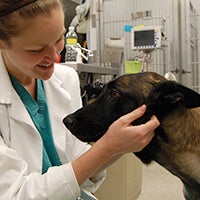
Ginger
A “veterinarian’s dog,” Ginger came to Penn Vet by way of the Mayor’s Alliance of New York City, with an abnormal blood vessel in her liver and an angular limb deformity in her front left leg. After undergoing procedures to correct both afflictions, Ginger was adopted by Penn Vet student Dierdre Weissman, V’08. Ginger then required additional surgeries to address a lesion on her ureter, resulting in the removal of a kidney. A physician from Thomas Jefferson University Hospital performed the ureter surgery using a procedure never before done on dogs.
Pictured with Ginger, from left: Deirdre Weissman, V’08, Dr. David Diefenderfer, V’81, Dr. Carrie Gurnee, Dr. Chick Weisse, V’98, and Alison Seward.
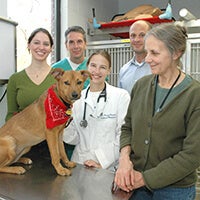
Chloe
Chloe underwent a hemilaminectomy to remove pressure on her spine after tumbling down the stairs. With the help of Ryan’s Rehabilitation Medicine Service, and a lot of at-home therapy, Chloe was walking again within two months.
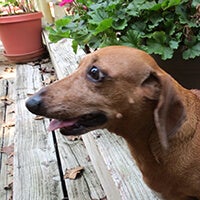
Alice
Alice arrived at Ryan Hospital with a wound on her nose and a shifted lower jaw. Radiographs of her head produced shocking results: part of a fiberglass arrow, about six inches long, was lodged in her skull. The three-bladed tip was a half-inch from her brain. After two surgeries to remove the arrow, “She made it through amazingly well,” according to Dr. John Lewis.
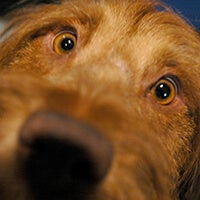
Olive
Tiny Olive arrived at Penn Vet with fluid in her lungs and air leaking from her lungs into her chest cavity. Emergency, Surgery, ICU, and vet students all had a hand in stabilizing and supporting her. She was placed on a mechanical ventilator to relieve her distress and make sure she was getting enough oxygen. Her progress was slow but after six days at Ryan, Olive went home.
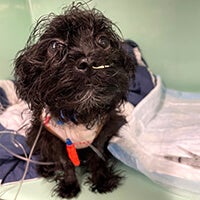
Basil
Basil, a German Shepherd puppy, underwent surgery in Ryan Hospital’s new minimally invasive surgery suite to correct a persistent right aortic arch, a congenital vascular abnormality of the heart, which shows clinical signs of regurgitation in young dogs. Pictured is Basil post-surgery in the ICU held by Jess Bosco, CVT.
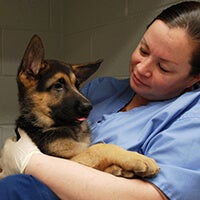
Sophie
Sophie became the first dog with a particular type of heart disease — arrhythmogenic right ventricular cardiomyopathy — to be treated with cardiac ablation, performed at Perelman School of Medicine’s Translational Cardiac Electrophysiology Laboratory. Collaboration between the two teams provided Sophie with a procedure that mirrored the best human medicine has to offer.
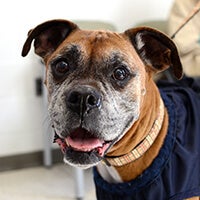
Joey and Jamie (and Yoyo)
Tony Rodgers and Mary Jane Cullin brought their cat Joey to Ryan Hospital for a renal transplant and adopted the donor cat, Jamie, who they named after nurse Jamie Meyer. While Tony spent time in recovery with Joey, he got to know YoYo, who was deemed unsuitable to donate during surgery, and decided to adopt him too!
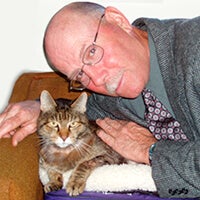
More from Bellwether
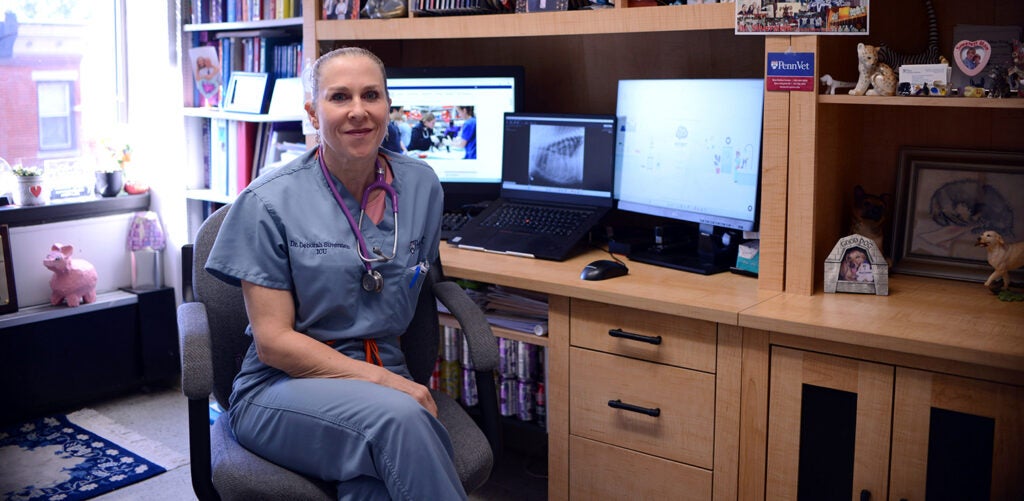
In the Office with Dr. Deborah Silverstein
Get to know Professor of Emergency & Critical Care Deborah Silverstein.
